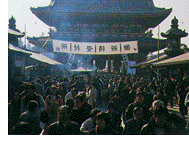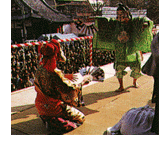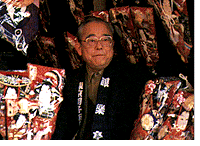 |
Winter Events in Asakusa |
|
|
|
|
Enjoy the four seasons in Asakusa
Some events may be canceled or postponed due to coronavirus(COVID-19) concerns.
Please check official websites for the latest updates and information. |
|
O-cha-tou-bi (Days for Acts of Merits) [December19, January1, Last day of Februaly] There are various special temple festivals for Buddhist deities. For example, since ancient times, the festival for the Kannon has been held on the 18th of May and the festival for the Jizo on the 24th. Additional days to perform acts of merit were established after the late Muromachi era. It was said that worshipping on one of these days brings the same benefits as worshipping for one hundred days or one thousand days, and these special days to perform acts of merit became very common all over Japan. O-cha-tou-bi is another name for this day. Following an old custom, believers drink the tea that has been first offered to the Kannon. Tea is actually offered to the Kannon every day, but only on the day for performing acts of merit are believers allowed to drink it. Believers formed an organization called the O-cha-tou-ko which is today named Gessanko and its membership now consists of more than 5000 believers. The O-cha-tou-ko at Sensoji was organized during the Tempo era (1830-1843) and the leaflets that were issued by the organizers at the time still exist today. Toshi-no-ichi (Market for new year's day) [December 17, 18, 19] Long ago when bartering was commonplace, regular markets were held in various places for the exchange of goods. In Edo, there were large markets three times a year. The largest was December and this one became known as toshi-no-ichi or year-end market. The Chirizukadan, written in 1814, described it as being the only year-end market where people came to buy New Year's decorations and pray for good luck. Until around the mid-Edo era, the only toshi-no-ichi for New Year's goods was held in Asakusa, on December 17 and 18, when people came to worship the Kannon for the last time of the year. It was called Asakusa-ichi or Asakusa market. Colored woodblock prints by Toyokuni depict this market which was an important annual event of old Edo. Until the mid-Edo era, only men went to the toshi-no-ichi. Samurai and prosperous merchants had their retainers or servants carry baskets and large chests as they streamed into Asakusa in large numbers to buy provisions at the same shop every year. On their way back, they stopped at restaurants to boost their spirits further and show off. Long ago, the toshi-no-ichi was not confined to the compound of Sensoji, but shops were also set up in the southern part of Asakusa in Komagata, Kuramae, Asakusabashi, and in the west, from Tawaramachi to Ueno Yamashita. An old senryu (Japanese satirical poem) depicts the popularity of this market: "Visitors to the market, Emerge from the crowd, Disappear into the crowd." An old ballad from the Edo era describes the atmosphere of Asakusa at the time: "The Asakusa market sells sacred Shinto straw decorations, ornaments, bitter oranges, sundry goods, wooden utensils, wooden pestles, flint stones, steel for a flint, trivets, kettle stands, grills, and tongs … Where shall we have some tea and rice? At the Tomoe-ya on Namiki Street or the Mannen-ya or the Seno. Well, I'll go to the Hana-ya. Today, I'm all worn out." Later in the Edo era, after this market was over, other markets were still held at Kanda Myojin, Fukagawa Hachiman, Shiba-atago Shrine, Yagenbori-fudo and other places, and women and children began going. After the Meiji era, ordinary shops also began to sell goods and provisions for New Year festivities, and this led to the gradual decline of the toshi-no-ichi. The hagoita-ichi (ornamental battledore fair), which began thriving instead in the late Edo era, now receives more attention and continues to draw large crowds. At Sensoji Temple, the portraits of two gods of good fortune, Daikoku and Ebisu-ten, are presented and an incantation is conducted on both December 17 and 18.
Ukiyoe artists lent their expertise, and the pictures, compositions, and colors grew more sophisticated and vivid. Later, in the late Edo era, battledores became the rage among women in Edo after they began featuring caricatures of popular Kabuki actors in famous roles. Women fans from all over Edo flocked to the hagoita-ichi at Asakusa Kannon to purchase hagoita showing popular actors from plays that had been successful that year. Because the hane or shuttlecock also signifies a wish that newborns will not be plagued by evil spirits and will grow up healthy, it has been a custom since long ago to give a hagoita as a gift upon the birth of a girl.
Giving a hagoita to wish for a healthy child and celebrating spring with a game of hanetsuki are customs that reflect the Japanese people's warmth and sense of beauty. About 50 merchants set up shops to sell hagoita in the compound of Sensoji Temple today. Joya-no-kane (New Year's Eve bell) [December 31] Joya-no-kane or the New Year's Eve bell of Asakusa at Bentenyama is well-known, as Basho, a famous haiku poet, depicted: "Ueno or Asakusa, which bell tolls more gaily?" The bell is rung 108 times, once for each passion to which humans are subject. The bell is rung by a group of 108 parishioners at midnight. At the tolling of the bell, Asakusa takes on a festive mood appropriate for the New Year, and the Nakamise area is crowded with finely dressed men and women on their way to pay a New Year's visit to Sensoji Temple.
Bentenyama Hatsumode (first New Year's visit to shrines and temples) at Asakusa Kannon [January 1]  Asakusa is thronged with people at New Year. Among the 840 major shrines and temples in Japan, Sensoji Temple always attracts a large number of visitors on New Year's Day. In the olden days, the temple closed its doors on New Year's Eve and opened them again at midnight on the morning of January 1. Today, with the large crowds of worshippers, the doors are kept open all night for reasons of safety, and Kaminarimon-dori and Umamichi-dori are closed to motor traffic.
Asakusa is thronged with people at New Year. Among the 840 major shrines and temples in Japan, Sensoji Temple always attracts a large number of visitors on New Year's Day. In the olden days, the temple closed its doors on New Year's Eve and opened them again at midnight on the morning of January 1. Today, with the large crowds of worshippers, the doors are kept open all night for reasons of safety, and Kaminarimon-dori and Umamichi-dori are closed to motor traffic.
The joya-no-kane (New Year's Eve bell) at Bentenyama is rung by parishioners 108 times, once for each of the passions to which human beings are subject, and when this happens, the compound of Sensoji Temple overflows with visitors. The doors of the Kannon Hall are opened at precisely midnight and good-luck charms and other objects to ward off evil fortune go on sale. The bell rings out the old year and rings in the new. People coming to worship are all smiles and the Nakamise area is crowded with a non-stop stream of visitors to the Kannon Hall who keep coming after daybreak and even three days later. In his short story, Odoriko (Dancer), Kafu Nagai, a famous Japanese novelist, described the New Year's visit to Asakusa: "The restaurants and drinking places inside and outside the park are crowded all night. After midnight, when it turns two or three in the morning, everywhere, from the alleyways to the park, is packed with people going to worship at a shrine or temple for New Year or at one that is located in a lucky direction, or with people returning with some kind of good-luck charm." The principal sacred image enshrined at Sensoji Temple is the Seikanzeon Bosatsu. It was discovered in the Sumida River by two brothers, Hinokuma Hamanari and Takenari in 628 and worshipped by the local people. Supported by their faith, Sensoji Temple expanded and grew to be a major temple. From January 1 to 6, a Buddhist ceremony called Shushou-e is held to pray for good luck and happiness in the coming year and to drive out evil spirits. For seven consecutive days, from January 12 to 18, the onza-hiho-darani-kai is held to pray for peace and good harvest.
Hatsumode at Famous Shichi-fukujin (Seven Gods of Good Fortune) in Asakusa Votive tablets of horses are offered to visitors until January 7.
Daikoku-ten (Sensoji Temple, 2-3-1 Asakusa)
Setsubun (bean scattering ceremony) [February 3] Ritual to Drive Out Evil Spirits at Sensoji Temple Setsubun refers to the day that marks the change of the seasons throughout the year. Originally, people observed four setsubun, one for each season, but nowadays the day before the first day of spring (risshun) is the only setsubun that is still celebrated. The custom of roasting soybeans and throwing them to drive out evil spirits is said to date from the Muromachi period (1338-1573) in Japan. Soybeans were probably chosen to symbolically destroy the demon's eyes or because the Japanese word for bean, mame, also means honest and hard-working.
The custom became popular among the common people after the Edo era, but at Sensoji Temple, the setsubun-kai or bean throwing ceremony that takes place on this day has been held since the Genroku period (1688-1703). Historical documents indicate that it was a famous event throughout Edo in the Kyoho period (1716-1734). Nowadays, a stage is set up outside on the east corridor of the main hall. Male parishioners volunteer to scatter beans from the stage and this is considered to bring good luck. Twice during the day, at 1:00 p.m. and 2:00 p.m., they make a procession that starts from Dempo-in, and after the Buddhist service is held, the bean-scattering ceremony takes place, but only a few strips of paper are thrown to guard against accidents.
Asakusa Kannon Celebrity Setsubun-kai
Fukujyu-no-mai (In commemoration of the opening of the Hozomon Gate of Sensoji Temple) [February 3] Shichifukujin-no-mai and Takara-no-mai  Shichifukujin-no-mai (Dance of the Seven Gods of Good Fortune)
Shichifukujin-no-mai (Dance of the Seven Gods of Good Fortune)
Since ancient times, the common people have worshipped the Shichi-fukujin (Seven Gods of Good Fortune) as gods who bring happiness and prosperity. One of the subordinate shrines of Sensoji Temple is also dedicated to the worship of the Shichi-fukujin and is a site of pilgrimage to honor them. The owner of the theater company, Ichimura-za, one of the three Saruwaka-za companies, was a devout believer in the Asakusa Kannon and he began giving a performance of the Shichi-fukujin-no-mai (Dance of the Seven Gods of Good Fortune) before his company's main performance as an act of religious merit dedicated to the Kannon. The Shichi-fukujin-no-mai is danced to nagauta music and is said to have been composed by the third Kineya Uemon, premier shamisen player of the Ichimura-za Theater Company sometime between 1716 and 1751. It was performed before the main performance every day as a customary opening act by the actors of Inari-cho (lower ranking actors) until the early Meiji era. Consequently, the Shichi-fukujin-no-mai by the Ichimura-za Theater Company has deep roots in Asakusa and was revived to commemorate the opening of the Hozomon Gate on April 1, 1964. In the dance, two of the gods, Ebisu and Daikoku, show their real faces, while the other five conceal their faces with masks. All the costumes and props are faithful reproductions of the Shichi-fukujin as they have been depicted since the olden days. Ebisu and Daikoku are the only ones to dance as the others watch from the rear of the stage.
Takara-no-mai (Treasure Dance) A treasure ship called Takarabune has been popular since ancient times as the ship on which the Shichi-fukujin appear. In the Takara-no-mai or "treasure dance" which celebrates the blessings and goodness of the Kannon, the treasure ship is pulled by many young children. This dance began in 1972 and it is performed by the children of Sensoji Kindergarten. Performance day : May 5(Children's Day) Hari-kuyo (Memorial Service for Broken Needles and Pins) [February 8] Awashima Shrine is surrounded by a semi-circular pond amid a grove on the west side the Kannon Main Hall. It is said to have been donated by Awashima Shrine located in Kada-mura, Kaisou-gun, Wakayama Prefecture before the Kyoho period about 290 years ago. Long ago, fishermen in the Wakayama region used to refrain from fishing on February 8 and tried to appease the God of the Seas by sinking broken fish hooks in the ocean bed; this apparently led to the custom of laying broken needles and pins in Awashima Shrine and conducting a memorial service for them. On this day, housewives, tailors, and makers of tabi (Japanese socks) and bags and pouches take a day off and bring their needles to the shrine. They place their old needles and pins in a sambo (Japanese navel orange) and stick the broken ones in tofu or konnyaku jelly and make an offering to the shrine. Today, this refined ceremony to show gratitude and appreciation attracts many women including students of Western and Japanese dressmaking. |
| Source: Asakusa Tourist Federation |
|
|
Exploring Delicious Asakusa | Asakusa Map |
|
| |||||
| Back to Menu | |||||
 Hagoita-ichi (ornamental battledore fair) [December 17, 18, 19]
Hagoita-ichi (ornamental battledore fair) [December 17, 18, 19]